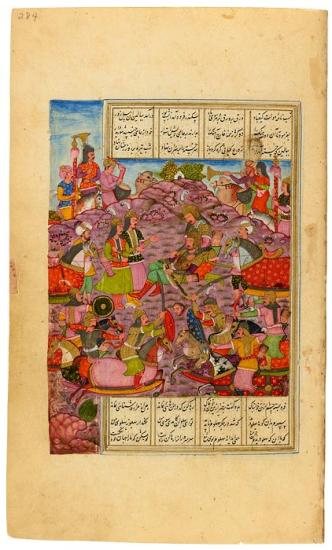Iskandar Comforts the Dying Dārā

Iskandar Comforts the Dying Dārā
Khamsa (Quintet), in Persian, written by Mullā Fatḥ Muḥammad
Purchased by Pierpont Morgan, 1910
Stories about Iskandar (Alexander the Great) were very popular and appear in Firdausī's epic Shāhnāma (Book of Kings) and, as here, in the fourth poem of Niẓāmī's Khamsa (Quintet), the Iskandarnāma (1194). In his quest to conquer Persia, Iskandar twice defeated Dārā (Darius III, r. 336–330 B.C.): in the battles at Issus (333 B.C.) and Gaugamela (331 B.C.) Before he could capture Dārā in another battle, two of Dārā's closest advisors conspired to stab him. Iskandar weeps as Dārā dies in his arms, asking Iskandar to care for his family and seek the hand of his daughter Roshanak in marriage. He then honors the deceased monarch with a royal burial. The two advisors, who stand before Dārā, thought their deed would be rewarded, but they were hanged instead.
Persian poetry
The Persians loved their poetry and their poets, though the Qur˒an warned against believing their words (sura 69.41) and "those straying in evil who follow them" (sura 26.224). While Arabic was the first language of Islam and the language of the Qur˒an, Persian was favored by poets. Even Firdausī's (940–1020) celebrated Shāhnāma (Book of Kings), the national epic of Persian, was written in verse—some 50,000 couplets! Rūmī (1207–1273), the best known of the Sufi poets, put poetry in perspective when he wrote, "A hundred thousand books of poetry existed / Before the word of the illiterate [Prophet] they were put to shame!" (Masnavī I, 529). Presented here are illustrations of Firdausī's Shāhnāma as well as works by Sa˓ dī (ca.1184–1292), Hāfiz (ca. 1320–1389), and Jāmī (1414–1492), regarded as the last of the great Sufi poets. Also featured are illustrations from each of the five poems of the Khamsa (Quintet), by Niẓāmī (ca. 1141–1209), especially Lailā and Majnūn (The Persian Romeo and Juliet) and Bahrām Gūr's Seven Princesses.